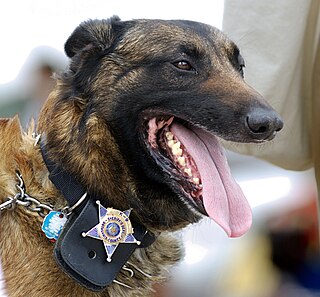
The Sixth Amendment to the United States Constitution sets forth rights related to criminal prosecutions. It was ratified in 1791 as part of the United States Bill of Rights. The Supreme Court has applied most of the protections of this amendment to the states through the Due Process Clause of the Fourteenth Amendment.

Search and Seizure is a procedure used in many civil law and common law legal systems by which police or other authorities and their agents, who, suspecting that a crime has been committed, commence a search of a person's property and confiscate any relevant evidence found in connection to the crime.
Katz v. United States, 389 U.S. 347 (1967), was a landmark United States Supreme Court case discussing the nature of the "right to privacy" and the legal definition of a "search" of intangible property, such as electronic-based communications like telephone calls. The Court's ruling refined previous interpretations of the unreasonable search and seizure clause of the Fourth Amendment to count immaterial intrusion with technology as a search, overruling Olmstead v. United States and Goldman v. United States. Katz also extended Fourth Amendment protection to all areas via the "Katz test" to determine when a person has a "reasonable expectation of privacy". The Katz test has been used in numerous cases, particularly with the advancement of technology that pose new questions on expectations of privacy.
Florida v. Riley, 488 U.S. 445 (1989), was a United States Supreme Court decision which held that police officials do not need a warrant to observe an individual's property from public airspace.
Expectation of privacy is a legal test which is crucial in defining the scope of the applicability of the privacy protections of the Fourth Amendment to the United States Constitution. It is related to, but is not the same as, a right to privacy, a much broader concept which is found in many legal systems.
Illinois v. Caballes, 543 U.S. 405 (2005), was a United States Supreme Court case in which the Court held that the Fourth Amendment is not violated when the use of a drug-sniffing dog during a routine traffic stop does not unreasonably prolong the length of the stop.
Smith v. Maryland, 442 U.S. 735 (1979), was a case in which the Supreme Court of the United States held that the installation and use of the pen register was not a "search" within the meaning of the Fourth Amendment, and hence no warrant was required.
The pen register was installed on telephone company property at the telephone company's central offices. In the Majority opinion, Justice Blackmun rejected the idea that the installation and use of a pen register constitutes a violation of the "legitimate expectation of privacy" since the numbers would be available to and recorded by the phone company anyway.
Suppression of evidence is a term used in the United States legal system to describe the lawful or unlawful act of preventing evidence from being shown in a trial. This could happen for several reasons. For example, if a judge believes that the evidence in question was obtained illegally, the judge can rule that it not be shown in court. It could also refer to a prosecutor improperly or intentionally hiding evidence that does not go with their case and could sugguest or prove to the judge or jury that the defendant is not guilty or that (s)he is legally obligated to show the defense. In the latter case, this would be a violation of the 5th amendment to the United States Constitution. Also Rule 3.8 of the ABA Model Rules of Professional Conduct requires prosecutors to "make timely disclosure to the defense of all evidence or information that tends to negate the guilt of the accused or mitigates the offense." This can result in a mistrial in the latter case and/or the dismissal of the prosecutor.
Oliver v. United States, 466 U.S. 170 (1984), is a United States Supreme Court decision relating to the open fields doctrine limiting the Fourth Amendment to the United States Constitution.
United States v. Martinez-Fuerte, 428 U.S. 543 (1976), was a decision of the United States Supreme Court that allowed the United States Border Patrol to set up permanent or fixed checkpoints on public highways leading to or away from the Mexican border and that the checkpoints are not a violation of the Fourth Amendment.
O'Connor v. Ortega, 480 U.S. 709 (1987), is a United States Supreme Court decision on the Fourth Amendment rights of government employees with regard to administrative searches in the workplace, during investigations by supervisors for violations of employee policy rather than by law enforcement for criminal offenses. It was brought by Magno Ortega, a doctor at a California state hospital after his supervisors found allegedly inculpatory evidence in his office while he was on administrative leave pending an investigation of alleged misconduct. Some of what they uncovered was later used to impeach a witness who testified on his behalf at the hearing where he unsuccessfully appealed his dismissal.
United States v. Payner, 447 U.S. 727 (1980), is a United States Supreme Court case in which the Court reversed a district court's suppression of evidence in the criminal prosecution of an Ohio businessman charged with tax evasion. The case concerned both issues of criminal procedure and the application of the exclusionary rule derived from the Fourth Amendment. By a 6–3 margin the Court both reaffirmed its earlier rulings' holding that only the party whose Fourth Amendment protections may have been violated has standing to challenge the evidence seized in the search, and barred lower courts from exercising their supervisory power to exclude such evidence at the trial of third parties.
Mancusi v. DeForte, 392 U.S. 364 (1968), is a decision of the United States Supreme Court on privacy and the Fourth Amendment. It originated in the lower courts as United States ex rel. Frank DeForte, appellant v. Vincent R. Mancusi, Warden of Attica Prison, Attica, New York, appellee, a petition for a writ of habeas corpus by a prisoner who had exhausted all his state appeals. By a 6–3 margin the Court affirmed the United States Court of Appeals for the Second Circuit's reversal of a district court denial of the petition.
United States v. Knotts, 460 U.S. 276 (1983), was a United States Supreme Court case regarding the use of an electronic surveillance device. The defendants argued that the use of this device was a Fourth Amendment violation. The device in question was described as a beeper that could only be tracked from a short distance. During a single trip, officers followed a car containing the beeper, relying on beeper signal to determine the car's final destination. The Court unanimously held that since the use of such a device did not violate a legitimate expectation of privacy there was no search and seizure and thus the use was allowed without a warrant. It reasoned that a person traveling in public has no expectation of privacy in one's movements. Since there was no search and seizure there was not a Fourth Amendment violation.
United States v. Jones, 565 U.S. 400 (2012), was a United States Supreme Court case which held that installing a Global Positioning System (GPS) tracking device on a vehicle and using the device to monitor the vehicle's movements constitutes a search under the Fourth Amendment.

United States v. Graham, 846 F. Supp. 2d 384, was a Maryland District Court case in which the Court held that historical cell site location data is not protected by the Fourth Amendment. Reacting to the precedent established by the recent Supreme Court case United States v. Jones in conjunction with the application of the third party doctrine, Judge Richard D. Bennett, found that "information voluntarily disclosed to a third party ceases to enjoy Fourth Amendment protection" because that information no longer belongs to the consumer, but rather to the telecommunications company that handles the transmissions records. The historical cell site location data is then not subject to the privacy protections afforded by the Fourth Amendment standard of probable cause, but rather to the Stored Communications Act, which governs the voluntary or compelled disclosure of stored electronic communications records.

Florida v. Jardines, 569 U.S. 1 (2013), is a decision by the United States Supreme Court which held that police use of a trained detection dog to sniff for narcotics on the front porch of a private home is a "search" within the meaning of the Fourth Amendment to the United States Constitution, and therefore, without consent, requires both probable cause and a search warrant.

Florida v. Harris, 568 U.S. 237 (2013), was a case in which the United States Supreme Court addressed the reliability of a dog sniff by a detection dog trained to identify narcotics, under the specific context of whether law enforcement's assertions that the dog is trained or certified is sufficient to establish probable cause for a search of a vehicle under the Fourth Amendment to the United States Constitution. Harris was the first Supreme Court case to challenge the dog's reliability, backed by data that asserts that on average, up to 80% of a dog's alerts are wrong. Twenty-four U.S. States, the federal government, and two U.S. territories filed briefs in support of Florida as amici curiae.
Hudson v. Palmer, 468 U.S. 517, is a United States Supreme Court case in which the Court held that prison inmates have no privacy rights in their cells protected by the Fourth Amendment to the United States Constitution. The Court also held that an intentional deprivation of property by a state employee "does not violate the Fourteenth Amendment if an adequate postdeprivation state remedy exists," extending Parratt v. Taylor to intentional torts.





